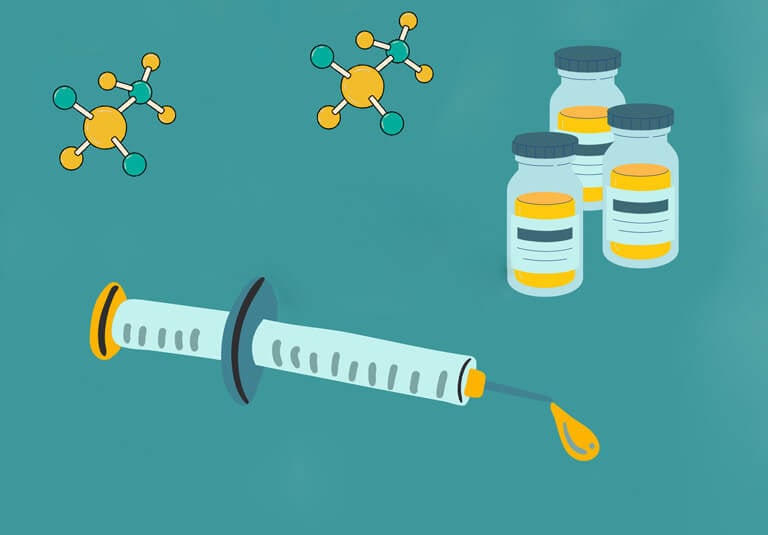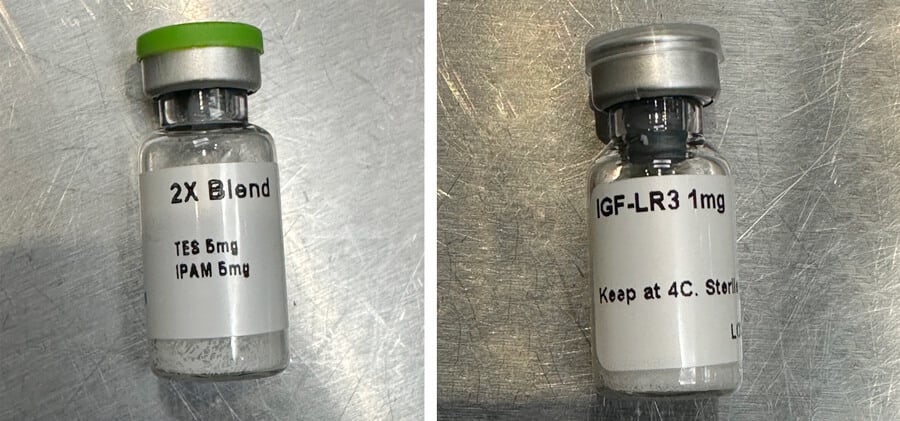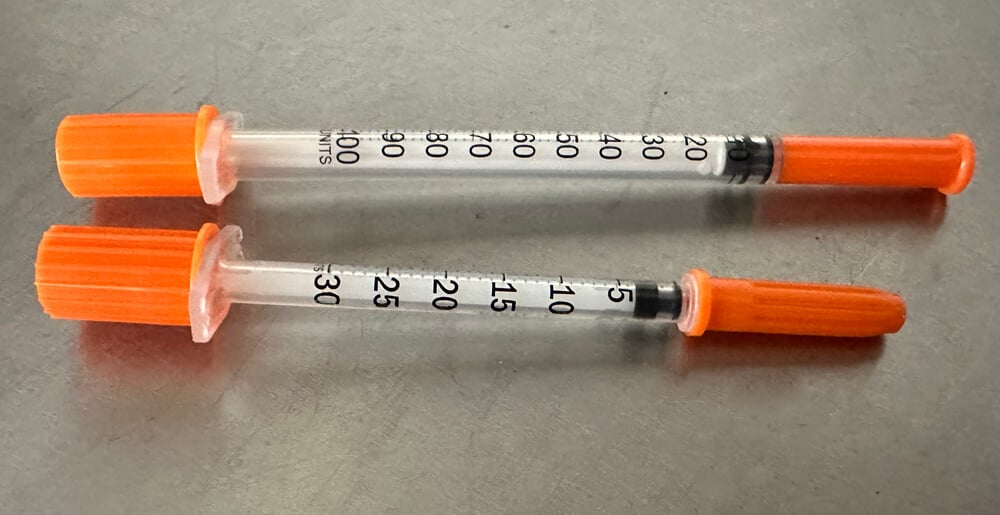Peptides for Bodybuilding

Uses of Peptides in Bodybuilding
In bodybuilding, peptides are popular for their potential to enhance muscle growth, fat loss, recovery, and overall performance. They work by stimulating the release of growth hormone, increasing protein synthesis, or improving healing and endurance.
Peptides are short chains of amino acids, typically consisting of anywhere from two to around 50 amino acids. They are the building blocks of proteins but are smaller in size. Peptides play essential roles in biological functions, acting as signaling molecules, hormones, neurotransmitters, and antimicrobial agents.
Sample Muscle Growth Peptide Stack

Reconstitute each vial with 1ml bacteriostatic water.
Ipamorelin/Testamoreline Blend. 5mg of each for 10mg total.
Function: Releases growth hormone.
Concentration: 5mg + 5mg of Ipam/tesa = 10mg or 10,000 mcg per vial total.
Dosage:* 200mcg or 0.2 units on the U-100 insulin syringe.
When to take: The best times to take the ipam/tesa combo are upon waking in the AM, post-workout and before bed. Most people find taking it in the AM the easiest.
How to take: Take in a fasted state or with just a lean protein meal as fats and carbs will blunt the release of GH. You can eat carbs/fats 20-30 min after the injection.
Frequency: f you’re training intensely, it’s possible to take more than one injection per day—for example, once upon waking and again after your workout. However, increasing the number of daily doses also raises the risk of side effects. With growth hormone, these can include a reversible, carpal tunnel–like sensation in the hands or wrists from water retention, as well as elevated blood sugar. At 1–2 doses per day, these issues are unlikely. A single daily dose can generally be continued long-term, but if you add extra doses, it’s advisable to periodically scale back to just one dose per day to reduce potential risks.
IGF-1 (Insulin-Like Growth Factor 1) L3:
IGF-1 is a peptide hormone that supports cell growth, repair, and metabolism. It promotes muscle development, fat utilization, bone strength, and tissue regeneration, while also offering neuroprotective and anti-aging benefits.
IGF-1 LR3 is a longer-acting synthetic version that stays active in the body much longer than natural IGF-1, making it more effective for sustained growth and recovery.
Function: Cell growth and repair
Concentration: 1mg per vial or 1000mcg
Dosage:* Starting dose is 50mcg which is 5 units on the u100 syringe. After a few weeks of the 50mcg dose, you can go up to 100mcg per dose, if everything is going smoothly.
When to take: The best times to take the IGF-1 would be post-workout on training days and in the AM on rest days.
You can take it at the same time as the ipam/tesa and the combination of the GH release and IGF-1 will greatly increase nutrient partitioning and anabolism/muscle growth. It will also help with fat burning. This is good for a 6-8 week cycle.
*The bodybuilding sample peptide stack above is dosed for a 30 year old male weighing 220lbs.
If you stack those together for 6-8 weeks with a good workout regiment and bodybuilding meal plan, I think you will be pleased with the results. Then, if you want, you can continue the ipam/tesa and then after a break resume another 6 weeks or so of the IGF-1. For bodybuilding you might look into SARMs.
Dosing Tools Needed for a Peptide Stack

U-100 and U-30 insulin syringes.
U100 insulin syringes can be used to mix bacteriostatic water with the peptides. Then, use U30 insulin syringes since they have a finer scale and allow for more accurate dosing. All U100 insulin syringes measure the same, but their size differences can make them look different.
Step-by-step mixing peptides with bacteriostatic water
For each of the vials, reconstitute them with 1ml bacteriostatic water.
Sanitize: Wipe the vial tops (IGF-1 LR3 and bacteriostatic water) with an alcohol swab.
Draw bacteriostatic water: Use an insulin syringe to draw up the desired amount of bac water.
Add slowly: Insert the needle into the IGF-1 LR3 vial and let the water run slowly down the inside wall of the vial (don’t spray directly on the powder—this can denature peptides).
Dissolve: Gently swirl (do not shake) until the powder fully dissolves. The liquid should turn clear.
Dose (mcg) |
1mL water added |
2mL water added |
3mL water added |
4mL water added |
5mL water added |
|---|---|---|---|---|---|
10 | 1 | 2 | 3 | 4 | 5 |
20 | 2 | 4 | 6 | 8 | 10 |
30 | 3 | 6 | 9 | 12 | 15 |
40 | 4 | 8 | 12 | 16 | 20 |
50 | 5 | 10 | 15 | 20 | 25 |
60 | 6 | 12 | 18 | 24 | 30 |
70 | 7 | 14 | 21 | 28 | 35 |
80 | 8 | 16 | 24 | 32 | 40 |
90 | 9 | 18 | 27 | 36 | 45 |
100 | 10 | 20 | 30 | 40 | 50 |
It can be a little tricky sometimes getting a good draw of liquid without too many air bubbles but you’ll get the hang of it. A little bit of air bubbles are harmless but has the potential to alter your dose measurement.
Other Supplements To Stack with Peptides
selective estrogen receptor modulators (SERM) can be used to increase testosterone. Enclomiphene an example that can increase testosterone while preserving fertility. Enclomiphene acts by blocking estrogen receptors, which helps to stimulate the production of luteinizing hormone (LH) and follicle-stimulationg hormone (FSH. These hormones, in turn stimulate the testes to produce testosterone.
Diet plan to support a muscle gain peptide stack
A diet designed to support a muscle-gain peptide stack should focus on a lean bulk with sufficient calories and macronutrients to fuel growth and recovery. Aim for roughly 3,500–4,000 kcal per day, with a macronutrient split of about 40% carbohydrates, 35% protein, and 25% healthy fats. High-quality protein sources like upper 2/3rds choice angus sliders, pan-seared swordfish, or shrimp scampi help maximize the muscle-building effects of IGF-1 LR3 and growth hormone, while complex carbohydrates provide energy for intense training, with carb cycling (higher carbs on workout days, lower on rest days) enhancing performance and recovery. Healthy fats, including avocado, nuts, and omega-3s, support hormone production and overall metabolic health. This approach ensures that your body has the nutrients needed to take full advantage of the anabolic effects of your peptide stack while minimizing fat gain.